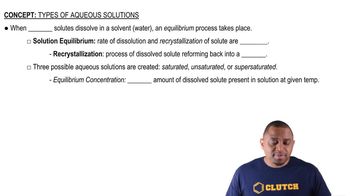Balance each redox reaction occurring in acidic aqueous solution. c. BrO3–(aq) + N2H4(g) → Br–(aq) + N2(g)
Ch.19 - Electrochemistry
Chapter 19, Problem 38c
Balance each redox reaction occurring in acidic aqueous solution. c. MnO4–(aq) + Al(s) → Mn2+(aq) + Al3+(aq)
 Verified step by step guidance
Verified step by step guidance1
Identify the oxidation and reduction half-reactions. MnO_4^- is reduced to Mn^{2+}, and Al is oxidized to Al^{3+}.
Balance the atoms other than O and H in each half-reaction. MnO_4^- to Mn^{2+} is already balanced for Mn, and Al to Al^{3+} is balanced for Al.
Balance the oxygen atoms by adding H_2O molecules. Add 4 H_2O to the right side of the reduction half-reaction to balance the 4 O atoms in MnO_4^-.
Balance the hydrogen atoms by adding H^+ ions. Add 8 H^+ to the left side of the reduction half-reaction to balance the 8 H atoms from the 4 H_2O.
Balance the charges by adding electrons. Add 5 e^- to the left side of the reduction half-reaction and 3 e^- to the right side of the oxidation half-reaction. Then, multiply the half-reactions by appropriate factors to equalize the number of electrons transferred.

Verified Solution
Video duration:
7mWas this helpful?
Key Concepts
Here are the essential concepts you must grasp in order to answer the question correctly.
Redox Reactions
Redox reactions, or reduction-oxidation reactions, involve the transfer of electrons between two species. In these reactions, one species is oxidized (loses electrons) while the other is reduced (gains electrons). Understanding the oxidation states of the elements involved is crucial for identifying which species undergo oxidation and reduction.
Recommended video:
Guided course

Identifying Redox Reactions
Balancing Redox Reactions
Balancing redox reactions requires ensuring that both mass and charge are conserved. This often involves separating the reaction into half-reactions for oxidation and reduction, balancing each half for atoms and charge, and then combining them while ensuring that the electrons lost in oxidation equal the electrons gained in reduction.
Recommended video:
Guided course

Balancing Basic Redox Reactions
Acidic Aqueous Solution
In an acidic aqueous solution, the presence of hydrogen ions (H+) influences the balancing of redox reactions. When balancing reactions in acidic conditions, H+ ions and water (H2O) are often added to balance the hydrogen and oxygen atoms, respectively. This context is essential for correctly applying the balancing method to the given redox reaction.
Recommended video:
Guided course

Types of Aqueous Solutions
Related Practice
Textbook Question
796
views
Textbook Question
Balance each redox reaction occurring in acidic aqueous solution. a. Zn(s) + Sn2+(aq) → Zn2+(aq) + Sn(s)
838
views
Textbook Question
Balance each redox reaction occurring in acidic aqueous solution. b. Mg(s) + Cr3+(aq) → Mg2+(aq) + Cr(s)
693
views
Textbook Question
Balance each redox reaction occurring in acidic aqueous solution. a. PbO2(s) + I–(aq) → Pb2+(aq) + I2(s) b. SO32–(aq) + MnO4–(aq) → SO42–(aq) + Mn2+(aq) c. S2O32–(aq) + Cl2(g) → SO42–(aq) + Cl–(aq)
Textbook Question
Balance each redox reaction occurring in acidic aqueous solution. a. I–(aq) + NO2–(aq) → I2(s) + NO(g) b. ClO4–(aq) + Cl–(aq) → ClO3–(aq) + Cl2(g)
647
views
Textbook Question
Balance each redox reaction occurring in acidic aqueous solution. c. NO3–(aq) + Sn2+(aq) → Sn4+(aq) + NO(g)
1269
views
